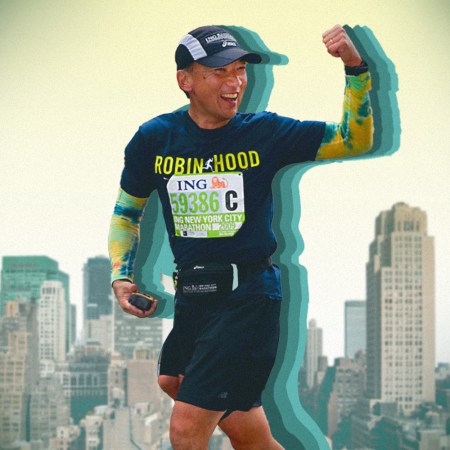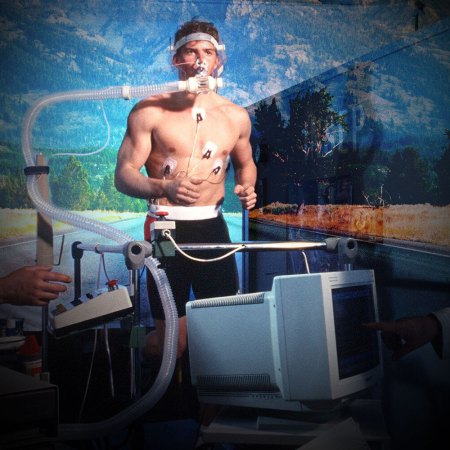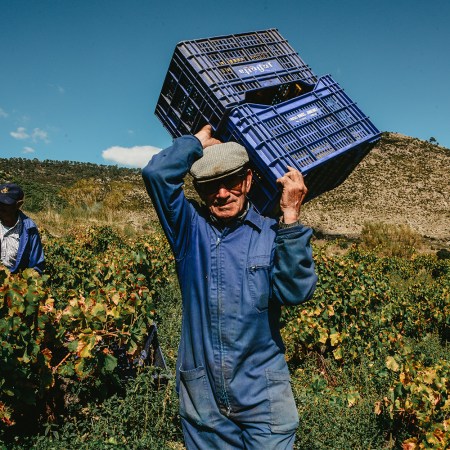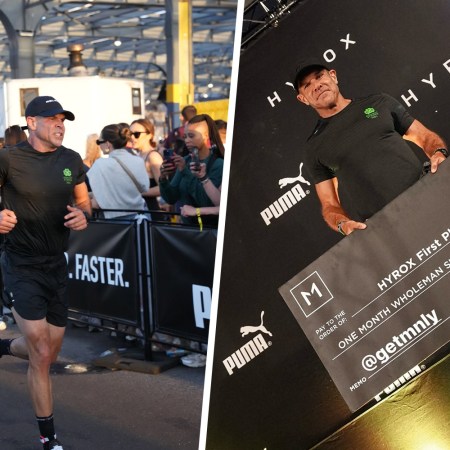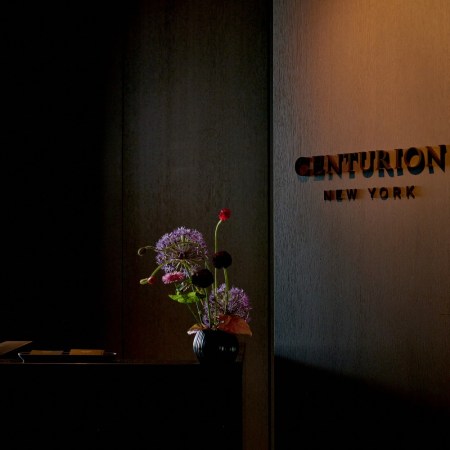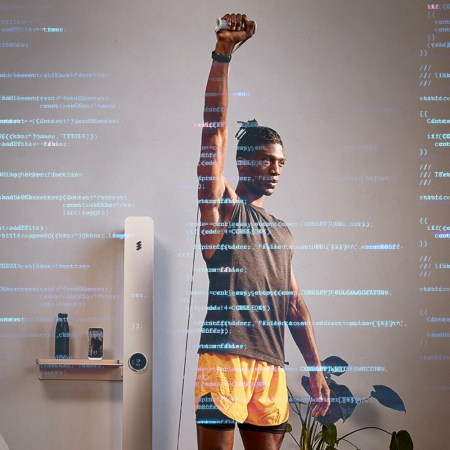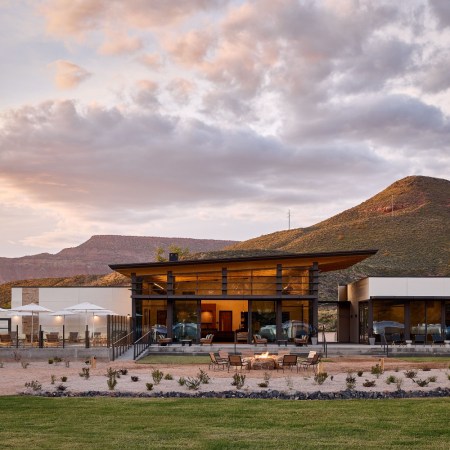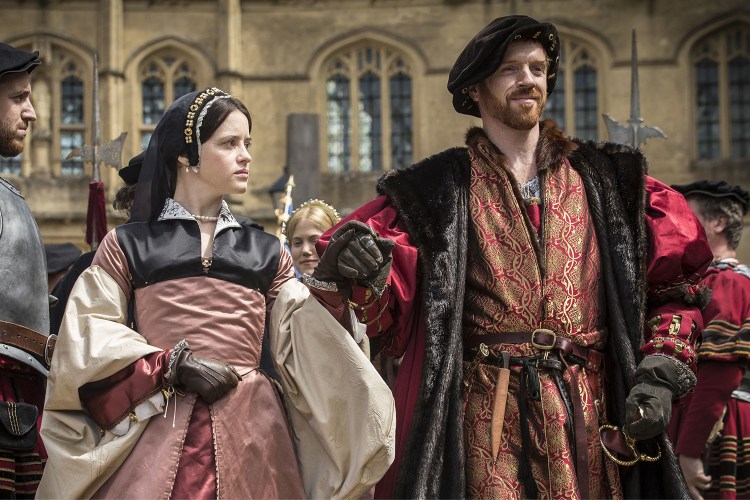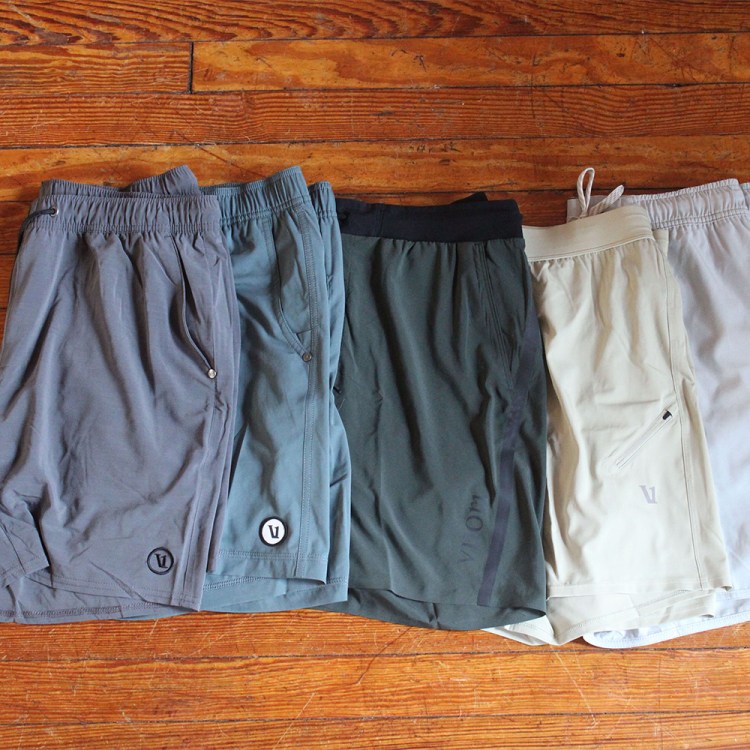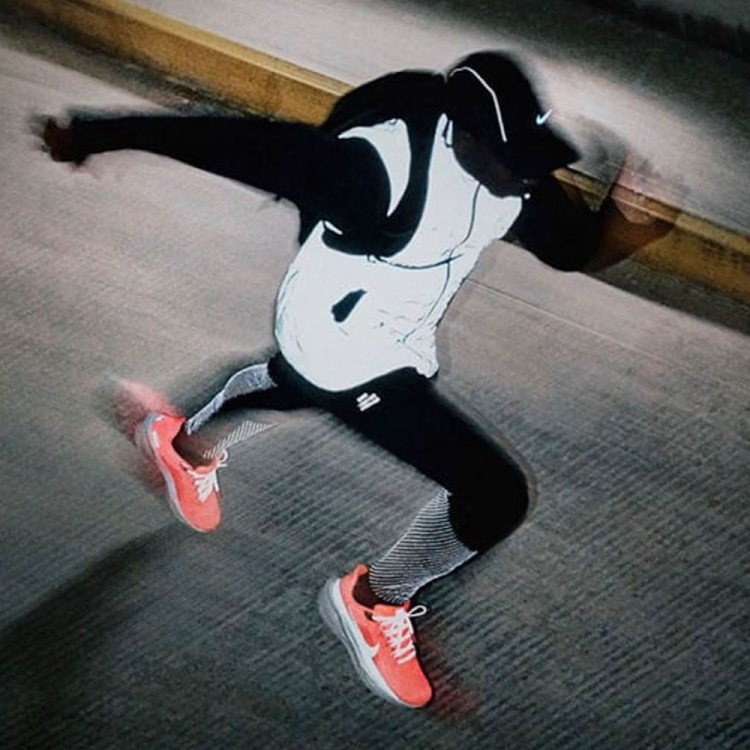“Just hold on and you’re goin’ home!” Jovy yells.
We don’t always have a finisher, but today we do — everyone is instructed to grab two extremely heavy weights, one for each hand, and stand in place, farmer’s carry-style, scapulae set back, for two minutes. If the dumbbells slip out of your hands, the whole room does push-ups, after which everyone has the privilege of picking them right back up.
“And start from the beginning?” someone asks, to groans. Don’t give him any ideas.
“Oh! Maybe!” Jovy replies. “No, no. Next time we’ll do that. Just don’t drop your weights. Don’t let each other down.”
In a stroke of genius, he presses play on Drake’s “Hold On, We’re Going Home.” The hypnotic bassline bounces off the dark basement walls, and there’s nothing to do but stand there, look at yourself in the mirror, try not to fuck this up. Jovy is on our side, ostensibly, but for the next two minutes he actively roots against us, calling out trainees who seem to be losing their grip on their weights.
“You’re shaking, James!” he says. I look to James, who has an 80-pounder in each hand. (I’m rocking with 50-pound dumbbells.) Jovy’s just spreading rumors; James looks cool as a cucumber.
“He isn’t shaking,” I say, “he’s singing!” It’s true: he’s lip-syncing now, absolutely locked in, bobbing his head in slow-motion to the music, making a meal of it. Meanwhile, I’ve somehow escaped Jovy’s gaze, though my chalked fingers are in agony, and the weights are starting to slip. My legs are quivering, too, as if foreshocks are rippling through Brooklyn’s upper crust. Oh boy.
But then, all of a sudden, it’s over. Finishers come in various, torturous forms — flutter kicks, commando planks, what have you — but they always finish, eventually. And then there is the relief, a sort of bone-tired euphoria, as if you’ve narrowly escaped death, followed by a legitimate desire to wipe down the floor, to re-rack the weights, to dish out fist bumps like candy, to thank Jovy, who, after all, isn’t our tormentor, but our trainer.
Some nights, people hang around to stretch or head out together for happy hour. Other evenings feature quick yet courteous calorie-seeking exits. It’s 7:30 p.m. and astronaut food would do. My walk home is slightly uphill, and takes about 10 minutes, but I cherish those footfalls. I am sweaty, wobbly, zapped by the workout, nourished by the company. When I take the final left onto my block, it feels like I’ve squeezed the last few drops from a lemon, and I can unlock my front door recognizing something like peace.
“It’s Just Mates Working Out”
I meet Dane McCarthy at coffee shop on a Wednesday morning in Williamsburg. He’s somewhere over six feet, built like one of those old body-opponent bags and wears a smile over a sweaty, black workout set. McCarthy is the founder of The Athletic Clubs (AC), a private-member wellness club with gyms in New York’s West Village, Greenwich Village, Meatpacking District and Williamsburg. Each gym plays host to a bevy of dedicated training “squads.”
I joined Williamsburg Athletic (WBA) in early June of this year. My squad is called “Clovelly,” named for a suburb along Sydney’s famous Bondi-to-Coogee Coastal Walk. Clovelly also happens to be where my Australian girlfriend’s mum lives, and the first place I ever visited in Australia. This wasn’t exactly why I jumped at claiming a slot, but it did seem like a good omen.
All AC squads are named for Australian beaches. McCarthy himself is Australian. He grew up in Sydney’s outer suburbs, moved to Bondi Beach at the age of 17 and eventually found his professional footing in tech sales. In 2020, he moved across the planet to take a job in New York City.
“I basically walked off the beach,” he laughs. “I stayed in StuyTown. I’d never seen snow before. When it first came, my boss called me and was like, ‘Hey, where are you?’ I’m like, ‘It’s fucking snowing. I’m at home.’ He said, ‘Get on the train.’ And then the pandemic hit.”

Winter ended, but quarantine commenced, and McCarthy found support in an outdoor workout group. “I just got together a bunch of people that I knew,” he says, “mostly ex-pats who couldn’t get home or whatever, and we started meeting together outside and training together with a personal trainer that we hired, a great guy from Jersey named Anthony Castelli.”
The group, 20 or so in total, got into the habit of meeting on Tuesdays and Thursdays at Pier 46, a turf lawn that extends into the Hudson River, perpendicular to Charles Street in the West Village. They’d all wear black — it was easier to find each other that way; anyone who wasn’t firing up a sourdough starter kit was outside those days — and they’d attack a difficult bodyweight workout as a group. Over the weekend, they’d go for a run together.
Even with the tutelage of Castelli, it was a pretty barebones operation. “We didn’t even have [resistance] bands,” McCarthy says. “It was just a mishmash of relatively fit people. We had like a little joke Instagram account. We called it West Village Athletic because it was in West Village.”
Since the group’s inception, passersby stopped to ask McCarthy and friends who they were, and if they could potentially get involved. “We were like, ‘Oh, not really. It’s just mates working out.’” But the requests followed them to social media, and after a while, it became harder to say no. As McCarthy remembers, “These guys were so keen. So we just started up a different squad that trained at the same time, a little bit further down the path. We hired them a coach. And it kind of just took off from there.”
The Gospel of Contrast Bathing
Sauna, ice bath, repeat. Here’s how the wellness world got obsessed with cycling between hot and cold.Decision Time
Before long, AC had snowballed into four different groups, nearly 100 members, and McCarthy faced a pairs of forks in the road. For one: how official did he and his friends want this thing to become? The various workout squads kept getting fined by parks and recreation. “The city was like, You can’t do this,” he laughs. And second: McCarthy was still working his full-time job. “I’m thinking, maybe I shouldn’t be focusing on this so much,” he remembers. He considered winding the whole operation down.
Around this time, a friend of McCarthy’s, whom he describes as a “quiet guy,” spoke up about how the Pier 46 training sessions had gotten him through a dark time. “He said that training that way had really supported him from a mental health perspective. It really changed the route he’d been on. I was like, shit. This is actually cooler than just doing some workouts. People are getting genuine value from this.”
Instead of winding down, McCarthy doubled down, committing to more coaches, actual branding and the collective’s first physical space, just in time for his second-ever New York winter.
“When it started getting really cold, we needed to find a place. And so I was walking past this studio that had gone under during COVID and ended up just calling the landlord and asking, ‘Can we move in?’ They were like, Who the hell are you? Do you even have a visa? Can you do this? But we finally got a space. And that’s when it really got serious. I had to get an LLC. I had to get a lease. Then it became a real business.”

Aussie, Aussie, Aussie
If it didn’t occur to McCarthy at first that the “training squads” model had unique mental health potential, perhaps that’s because the concept is quite common in his native country.
In Australia, “you’re always training with your mates,” says McCarthy, who grew up playing rugby. “I didn’t go to a group class like a Barry’s or a Rumble until I moved here. I was always with my closest guy friends. We’d go out to the beach, someone would run a circuit, probably the fittest guy, and we would run around and then go get a coffee. I was really missing that when I moved over.”
McCarthy felt overwhelmed by America’s vast menu of workout options, calling them “exciting” and “entertaining,” while noting that they lack intimacy or accountability. “I went to none of them,” he says. “I found it so hard to get back into my fitness because I’d been used to being in this team environment where if you didn’t show up to a session, coach would message you or someone would message you.”
It’s a refrain I’ve heard from peers for years — and at one point confronted myself. When you lose the support and structure of a team (in which training often doesn’t feel like training at all, but rather the necessary work required in service of a common mission, like achieving a championship), where do you turn? What do you do without the steady expectation of showing up for “practice”? Without an obvious goal to shoot for, or teammates to go to battle with, or a mentor tracking your commitment and celebrating your progress, what’s even the point? Fitness can start to feel awfully solitary, and at the very least not that much fun. It’s loading the dishwasher each day. Waiting for the train.
Many erstwhile athletes spend their 20s falling down a rabbit hole known as “detraining.” Functionally speaking, it’s the gradual loss of fitness that sets in as organic training gives way to the sedentary rigors of adulthood. Lyrically speaking, it’s the bar hound in Bruce Springsteen’s “Glory Days” bragging about his old speedball. Still, as deep, dark and aimless as a detraining hole can feel, it only takes a single experience to pull an individual up and out of it.
This is actually cooler than just doing some workouts. People are getting genuine value from this.
– Dane mccarthy, Founder of The Athletic Clubs
If you spend some time in Sydney, it’s impossible to ignore the local affinity for squad training. They’re up and at it with the sun. Australians are the earliest-rising populace in the world (waking up just after 6:45 a.m., on average). To go outside at 8 a.m., still rubbing your eyes as you walk into a bustling cafe, is to feel like you’ve missed the day.
Australia is a sporting nation, which famously out-punches its weight at the Olympics, and a coastal one, which pioneered many of the world’s first surf rescue clubs. (What we would call lifeguarding, or beach patrol.) The country doesn’t just count the Hemsworth boys and avocado toast among its key exports; it’s also sent a number of workout concepts to the States over the years, including F45 Training, 12RND Fitness, Body Fit Training, KX Pilates, Happy Melon Studios and Flow Athletic.
Some of those have offerings similar to the American classes that McCarthy didn’t care for. “Don’t get me wrong, people in Oz train in classes,” he says. But there’s an undercurrent of team training baked into the Aussie model. “F45 actually got started by a guy who played at my rugby club a couple of years older than me,” he adds. “And he had a similar insight. He wanted team training. That was kind of how that evolved.”
It doesn’t hurt, either, that on account of their association with wellness, Aussies have earned the faith of American trainees. Another Australian, Luke Milton, has cultivated this concept in Los Angeles, with his Training Mate clubs: HIIT workouts with celebrity devotees. They lean into the Southern Cross more heavily than at AC (greeting members with a rousing “G’day!”), but the core conceit remains.
Growing up, Milton was with teammates pretty much year-round. In the winter, he played soccer and rugby, and in the summer he participated in junior surf lifesaving. At the age of 18, he turned pro in rugby, representing Australia on the international stage. He founded Training Mate in 2009, which he describes as “a supportive team environment…where our trainers walk throughout the room communicating with our clients, not up on a podium, and we encourage everyone to build their social health.”
“Aussies are social beings,” Milton wrote to me over email. “I personally believe we all are as humans, but Aussies really value mateship. Just that word — mate — is so unique. Mateship is taught from an early age in Australia; team sports are a part of our DNA…the Australian childhood is filled with team environments and activities that cultivate a culture of human connection.”

What’s in a Workout?
While some of AC’s studios are situated at street-level, the Williamsburg facility is in the basement of a six-story mixed-use building. It’s not much: there’s a hallway with lockers, a pair of bathrooms, a room for stretching and then the main stage itself, a rectangular room with weights, squat racks and a wall-length mirror, which barely fits 15 people and sometimes smushes in 20.
Hanging from the ceiling are two TVs that display the day’s programming. It typically consists of four stations, two or three exercises at each, to the tune of 12-minute increments. Three of these stations focus on strength, while one is devoted explicitly (notoriously) to conditioning. Because everyone has to cycle through every station, there’s a chance you’ll have to start with conditioning. Some people go to great lengths to avoid this, making sure to park themselves on the opposite side of the gym during the warm-up.
I kind of prefer to start with conditioning, though. It definitely isn’t easy — think calorie rounds on the rower or SkiErg, interspersed with kettlebell swings or burpees — but it feels good to get it out of the way. And besides, the whole workout involves a great deal of conditioning. In the strength sections, you’re likely to find yourself performing Romanian deadlifts, plyometric push-ups, box jumps, Bulgarian split squats, V-crunches or pull-ups, plus all manner of presses and rows.
AC does organize its calendar into training phases, cycling between volume blocks and heavier lifts, but I’ve found that the workouts tend to favor a high-rep, low-weight approach. Depending on the station, you may find yourself performing an exercise for “as many reps as possible” (AMRAP), switching places with a partner “every minute on the minute” (EMOM) or super-setting (no fun abbreviation for this one), which means leaping from one exercise into the next without pausing.
I couldn’t even tell you if the workout passes quickly or slowly; that basement has a habit of bending time, of collapsing minutes into moments. You’re just trying to do the next thing right. The music’s loud, arms are flying through the air and dumbbells are rolling around the floor. Over my first few sessions, I was terrified of messing up — yet simultaneously too nervous to ask our trainer if I was performing certain moves correctly.
Our fundamental belief is that if you enjoy training and being around people, you’re gonna be more consistent.
– Dane Mccarthy
For many newcomers, the intensity of the workout probably justifies the intimidation they feel walking down those stairs. McCarthy says AC is going after people “who really wanna be fit and healthy, but it’s not their whole life.”
“They’ve got a full-time job,” he says. “They don’t need to put 200 pounds over their head, they don’t need to be able to handstand-walk over an obstacle.” But many members maintain a gym membership in addition to their enrollment at AC, and have big-ticket fitness goals on the horizon, like a marathon, or HYROX, the race series that has taken the fitness world by storm over the last 18 months.
When I ask McCarthy whether AC is “teaching to the test,” vis-à-vis HYROX — as the event features similar exercises, and AC had a big presence at the New York race — he says that the two brands’ concurrent rise in popularity is coincidental. But yes, “if you train with us, you’re gonna be very well equipped to do HYROX.”
Whatever level of fitness (or confidence) you join AC at, you’re probably going to get stronger over time. Regular strength and conditioning stabilizes your core and spikes your VO2. A recent study summed up the benefits of strength training succinctly: it delays death. But the key word in the last two sentences is “regular” — to glean the greatest benefits, you have to show up week after week, month after month, and put in the work. It’s hard on your own. And therein lies the appeal of the squad setting, where accountability reigns supreme.
According to research published in the academic journal Sport, Exercise, and Performance Psychology, exercising with others increases the “affective valence” of the activity, which is a fancy way of saying that trainees perceive group fitness as essentially valuable and good. They tend to enjoy the activity more, work harder than they might have on their own and feel motivated (perhaps even compelled) to return, time and time again.
McCarthy’s pitch echoes the research: “Our fundamental belief is that if you enjoy training and being around people, you’re gonna be more consistent. So that’s the core tenet, right? If you have people who care about you and hold you accountable, it’s gonna get you to train.”
With great accountability, there is a steady rise in affability. By the third week of sessions, I wasn’t holding back from asking any of our trainers how I should perform a specific move (or when my left rotator cuff was bothering me, if there was an alternative exercise to overhead shoulder presses). You settle in. You make friends. At the very least, you develop a collegial rapport with people you start seeing for two hours a week. It’s possible to get comfortable in a challenging environment, oxymoronic as that may sound.
The WhatsApp Effect
Many members haven’t just “settled in” at AC. They’ve literally changed their lives. McCarthy estimates that 10 to 15 people have found new jobs with the help of squad mates. And there were two weddings this year for couples who met through training.
I’d make a joke that run clubs aren’t the only fertile ground for the city’s fitness-minded singles, but AC does, in fact, operate its own rolling run clubs throughout the week.
Based on when your squad meets (Monday/Wednesday or Tuesday/Thursday), there is a morning run club for you. AC acolytes meet at the base of bridges for hill sprints or the starting line of tracks for repeats; and on weekend mornings, squads from different neighborhoods have a chance to intermingle via Stone 2 Stone, a six-miler from the sacred ground at Pier 46, all the way up to Central Park. Bluestone Lane coffee (another Aussie import) awaits in cardboard carafes.
As is the case in most private-member social clubs, an individual’s AC experience is ultimately determined by how deeply they choose to delve into its suite of offerings. Beyond the humdrum of weekly sessions and the occasional happy hour, there are additional classes (a strength club, or a popular weekend program called “Brunch Burn”), one-off workouts with groups like HPLT (Brian Mazza’s training lab) or Club Pillar (a sober dating club), and even a sort of inter-squad Olympics, called the AC Games, in which four-athlete teams push through deadball squats and 4000-meter intervals on the bike erg for points.
I was amazed to discover that this entire universe is more or less supported by WhatsApp. AC has a newsletter, and a ClassPass-esque app for booking classes, but the brunt of the action is on the messaging app, where members RSVP for classes, hype up fresh faces and coordinate events outside the explicit jurisdiction of the company, like playing pickleball or pre-gaming raves. There are also dedicated groups for selling desk chairs, finding a sublet or hiring a babysitter. And there are even appreciation groups, too: McCarthy cites one for Taylor Swift, another for F1.
“This is all just member organized,” he says. “There were 120 people who went skiing in Austria last year. They’re doing it again. There are these sub-communities that build out, which is really cool.”

I’m from the greater New York area and am lucky enough to have a deep base of friends and family nearby, but it’s easy to imagine the social avenues that this level of community must pave for someone new to the city (like McCarthy himself, or some of my squad mates in Clovelly, who hail from the likes of London, Madrid and Montenegro). Thanks to McCarthy’s friend, who opened up about how that early-days iteration of AC helped him back in 2020, hundreds more people now have a “third place” to cultivate their physical and mental health.
Thousands more stand to benefit beyond AC’s ecosystem. The group hosts quarterly dinners, a summer party and a winter gala to fundraise for causes like Free Arts NYC and the New York Center for Children.
Meanwhile, AC’s packed calendar means that its trainers need to be a little more involved than just showing up and shouting exercises like a drill sergeant.
“We’re not just asking them to be really good coaches. We’re asking them to be community managers,” McCarthy says. “It’s pretty hard to find. In the early days, I ended up having to coach some classes. My goodness, it’s hard. Trying to keep people safe, while entertaining them, while keeping things running on time, while playing fire music. They’re responsible for checking in on each of you individually. They’ve got some administrative tasks.”
But a nascent trainer could do worse than hitch their wagon to AC, which has received an angel investment from Anne Manhlum, the founder of Solidcore, and plans to launch permanent programs in Hoboken and Flatiron soon, while adding more squads in fitness-happy Williamsburg. As of now, membership stands at $235 a month, including squad sessions, and a fair share of add-ons like strength sessions or run club. Members who attend the most classes in a month see the $235 fee waived.
Of course, this sum does not account for Gatoritas — an irreligous lemon-lime/tequila concoction — which trade for $9 these days at The Levee, the prickly heritage bar two doors down from WBA. It doesn’t account for the coffee at Partners, either, or the banana bread that sometimes single-handedly motivates run clubbers to rise with the pigeons. But these things are worth it. Like 50-pound kettlebells, they’re best enjoyed with a bit of company.
Whether you’re looking to get into shape, or just get out of a funk, The Charge has got you covered. Sign up for our new wellness newsletter today.


